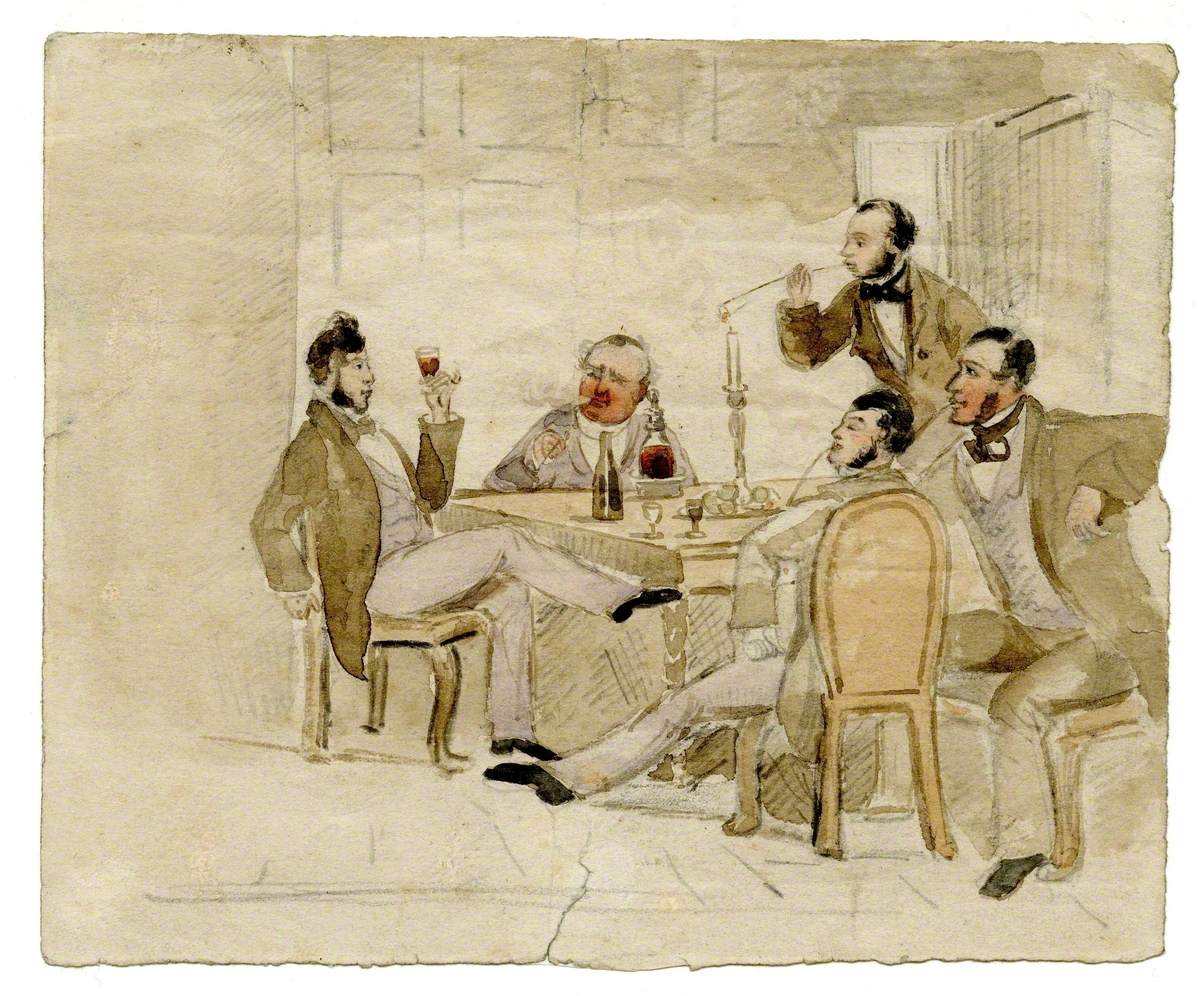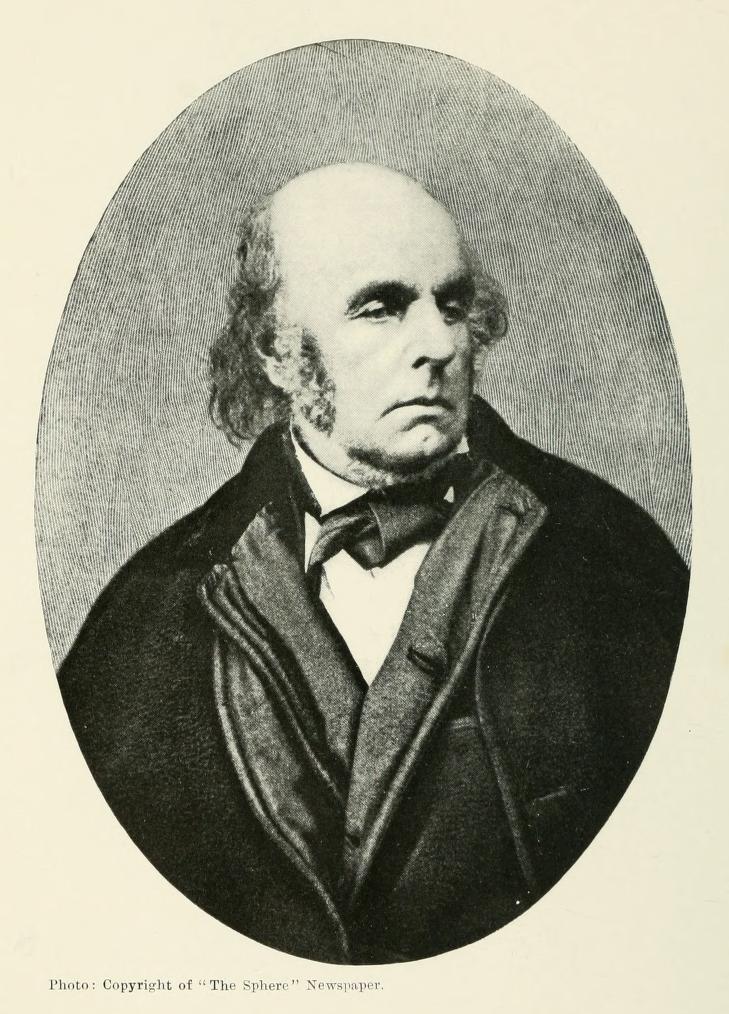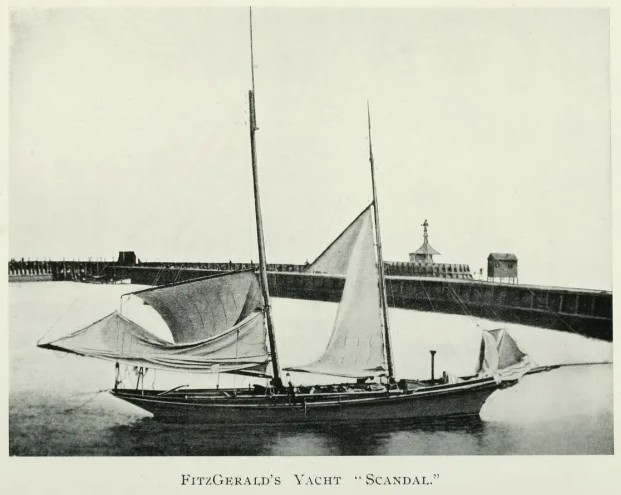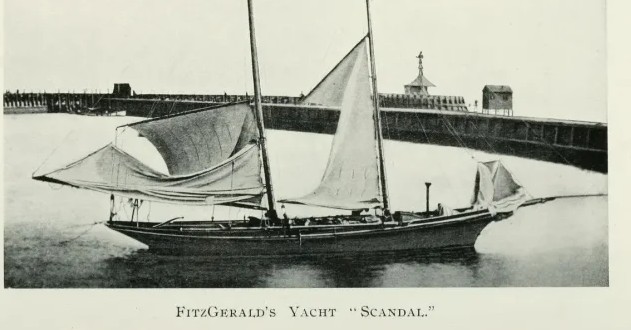Edward Fitzgerald (1809-1883) was from a wealthy family and a gentleman of leisure. Known primarily for his translation of a Persian poem he was of a bohemian disposition and lived an unconventional life. He was one of the ‘Woodbridge Wits’, a group of poets and artists, which included Thomas Churchyard, George Crabbe and Bernard Barton1Woodbridge Wits see Constable and the Woodbridge Wits.. Perhaps Churchyard had them in mind with this work?

Photo credit: Colchester and Ipswich Museums Service: Ipswich Borough Council Collection
Considering that he, to a large extent, enjoyed a life of pleasing himself, he was the subject of several biographies and studies (see sources).

Fitzgerald was a keen yachtsman, of a sort. He first owned a half-decker, the Waveney, which he sailed on the Deben, or rather his crew sailed for him: then he had a larger boat built, the 14-ton Scandal2Scandal was built in Wivenhoe by John Harvey in 1863, and cost £350, 14 tons- although note that there were several weight measurements at the time so this is not comparable. There is more detail of Wivenhoe boat-building and the interesting history of the yard in ‘RIVER, COAST and CREEK – An Exploration of Maritime Essex by Judith Ellis’, in the photograph. The name Scandal was supposedly because he thought that this was the only thing to come out of Woodbridge. He whimsically named her tender ‘Whisper‘, a clever pairing.
He engaged a captain and mate to sail her for him and appears to have spent much of his time reading. Most of the time his captain was Tom Newson, a Felixstowe Ferry pilot. Whilst Fitzgerald spent much of the summer afloat, he had little in the way of seamanship, leaving it to the crew while he read. One of his letters discusses getting ‘coke’ (a form of smokeless coal that was a by-product of coal for town gas) for the stove since the coal smoke sullied the sails. It was said, perhaps unreliably, that he always wore a silk hat and feather boa, so would have made an interesting sight.
Fitzgerald made a few trips to the South Coast and the Continent, but these were not to his taste and most of his sailing was on the Suffolk and Norfolk coasts. He took great pleasure in mixing with ordinary seamen at the Ferry, Aldeburgh and Lowestoft and, through this, wrote a collection of Sea Words and Phrases Along the Suffolk Coast. His thoughts on sailing were expressed here in a letter:
My chief Amusement in Life is Boating, on River and Sea. … So I get to the Water: where Friends are not buried nor Pathways stopt up : but all is, as the Poets say, as Creation’s Dawn beheld. I am happiest going in my little Boat round the Coast to Aldbro’, with some Bottled Porter and some Bread and Cheese, and some good rough Soul.
Letters & literary remains of Edward FitzGerald
Through his maritime socialising, he met his particular friend ‘Posh’, or Joseph Fletcher of Lowestoft, almost thirty years his junior. Together, they formed a Herring fishing business which Fitzgerald financed: they had a boat built, affectionately named Meeum & Tuum (L: Mine and Thine). Posh was the main reason why Fitzgerald spent so much time in Lowestoft until their relationship faltered.
He did at least four things of local maritime significance.
- Fitzgerald’s publisher, and a close friend, in Woodbridge, was John Loder. Fitzgerald referred to him as: ” …and Loder is a Rock of Ages to rely on.”3‘More Letters,’ p. 283 (1901). When Loder lost a libel case, it was Fitzgerald who caused a public subscription to be raised, probably also contributing a large share, to help. This resulted in Loder’s Cut which was of great benefit to the port’s traffic.
- He was to raise the subject of the Woodbridge Haven buoys with a friend who had influence at Trinity House. This resulted in a larger buoy being installed at the entrance. However, this is unlikely to have been on the scale of the modern Woodbridge Haven buoy.
- In 1861 George Tomline, who was the landowner, planned to enclose Martlesham Creek to make a decoy pond, similar to the one at Levington. It seems to have been Fitzgerald’s campaigning that prevented this. The enclosure of the river was common at the time: an area north of Methersgate Quay was enclosed around 1845 and, later, there was a failed attempt to enclose between the Hams and Tips. Fitzgerald was opposed to the local ‘squirearchy’ who wanted to enclose sections of the river bank and forbid the use of the river walls to the public4Fitz’s thoughts on Squires: The Country about here is the Cemetery of so many of my oldest Friends : and the petty race of Squires who have succeeded only use the Earth for an Investment : cut down every old Tree : level every Violet Bank : and make the old Country of my Youth hideous to me in my Decline. There are fewer Birds to be heard, as fewer Trees for them to resort to. So I get to the Water : where Friends are not buried nor Pathways stopt up : but all is.. Presumably, this was because landowners had ownership down to the low water line.
- Fitzgerald collected and published Sea Words and Phrases Along the Suffolk Coast which includes some quaint expressions not used today.

Note how the sails are “scandalised”, clearly some thought went into the composition.
Eventually, feeling his age and following the rift with Posh, Fitzgerald sold Scandal to William Cuthbert Quilter, who was to eventually build Bawdsey Manor: he renamed her Sapphire although soon upgraded to grander yachts.
Scandal had a long career after this. Her rig was altered to a cutter then a ketch: she was eventually scrapped after being damaged in 1930, a life of nearly seventy years. Thomas Churchyard5There is a collection of Churchyard paintings online. made a sketch of her, this one is closest albeit a poor representation of Scandal.
Sources
Frank Hussey, Old Fitz: Edward FitzGerald and East Coast Sailing, The Suffolk Library (Ipswich: Boydell Press, 1974). – The best account of EFG and the sea and the source for much of this post.
This is a very good summary of EFG.
template (woodbridgevirtualmuseum.com) for details on Fitzgerald.
Robert Simper, ‘Woodbridge and Beyond’, 1972
Edward FitzGerald 1809-1883 » Boulge Church (onesuffolk.net)
Edward FitzGerald – Poems by the Famous Poet – All Poetry
Internet Archive: Digital Library of Free & Borrowable Books, Movies, Music & Wayback Machine
Woodbridge Society Blue Plaques
Edward FitzGerald collection at Woodbridge Library
Covers most of FitzGerald’s publications, including translations from foreign languages.
- Dates covered: 1809 – 1880
- Material included: Cuttings, ephemera (e.g. posters), books
- Location: Woodbridge Library
Footnotes
- 1
- 2Scandal was built in Wivenhoe by John Harvey in 1863, and cost £350, 14 tons- although note that there were several weight measurements at the time so this is not comparable. There is more detail of Wivenhoe boat-building and the interesting history of the yard in ‘RIVER, COAST and CREEK – An Exploration of Maritime Essex by Judith Ellis’,
- 3‘More Letters,’ p. 283 (1901)
- 4Fitz’s thoughts on Squires: The Country about here is the Cemetery of so many of my oldest Friends : and the petty race of Squires who have succeeded only use the Earth for an Investment : cut down every old Tree : level every Violet Bank : and make the old Country of my Youth hideous to me in my Decline. There are fewer Birds to be heard, as fewer Trees for them to resort to. So I get to the Water : where Friends are not buried nor Pathways stopt up : but all is.
- 5
Image Sources and Credits
Image Credits and Sources
- ; A Convivial Gathering at Woodbridge: Photo credit: Colchester and Ipswich Museums Service: Ipswich Borough Council Collection
- 1
- 2Scandal was built in Wivenhoe by John Harvey in 1863, and cost £350, 14 tons- although note that there were several weight measurements at the time so this is not comparable. There is more detail of Wivenhoe boat-building and the interesting history of the yard in ‘RIVER, COAST and CREEK – An Exploration of Maritime Essex by Judith Ellis’,
- 3‘More Letters,’ p. 283 (1901)
- 4Fitz’s thoughts on Squires: The Country about here is the Cemetery of so many of my oldest Friends : and the petty race of Squires who have succeeded only use the Earth for an Investment : cut down every old Tree : level every Violet Bank : and make the old Country of my Youth hideous to me in my Decline. There are fewer Birds to be heard, as fewer Trees for them to resort to. So I get to the Water : where Friends are not buried nor Pathways stopt up : but all is.
- 5
Image Credits and Sources
- ; A Convivial Gathering at Woodbridge: Photo credit: Colchester and Ipswich Museums Service: Ipswich Borough Council Collection
